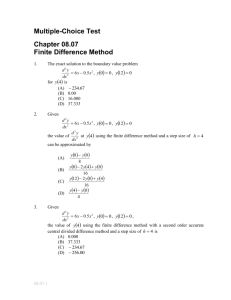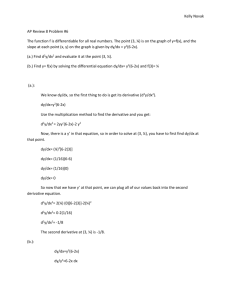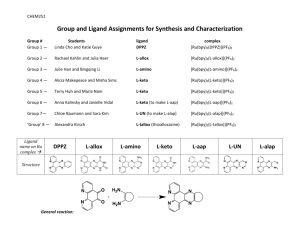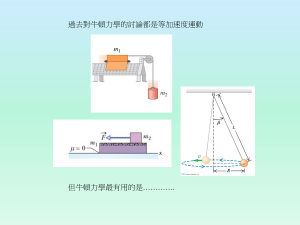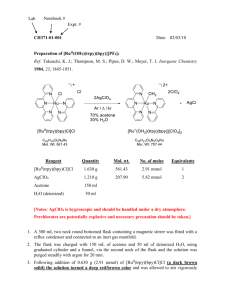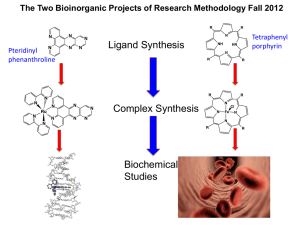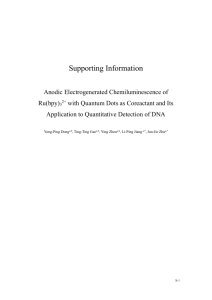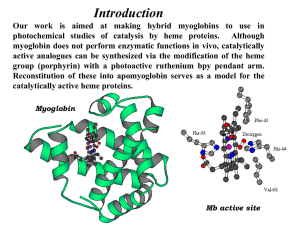Ru Complex Synthesis
advertisement
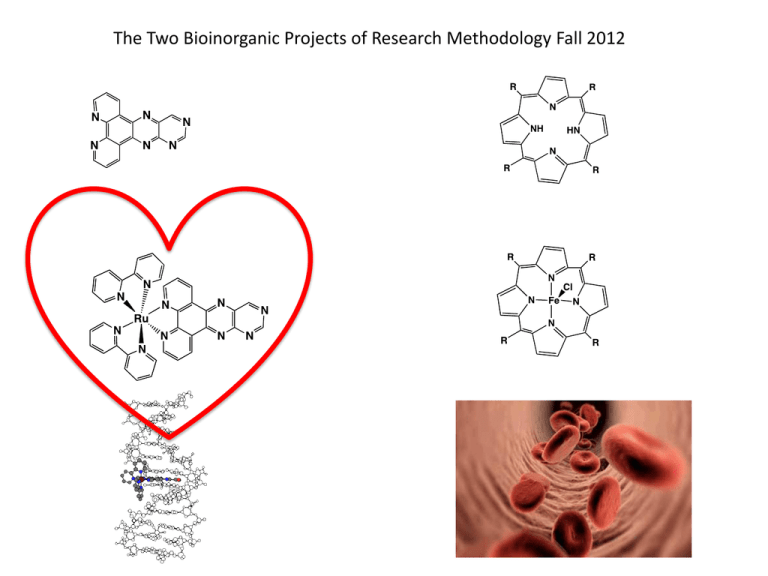
The Two Bioinorganic Projects of Research Methodology Fall 2012 Ligand synthesis MeOH 20 h or so in NaOH pH ~11 Solvent : aqueous ethylene glycol What is the significance of this project? Tris-chelate Ru compexes bind to DNA… … where the strength of binding corresponds to a match of chirality between the Ru complex and DNA Look at how snugly this ‘red’ complex fits into the groove: B-DNA is a right hand helix and that red complex is “right-handed” too! How can that be? [Ru(bpy)2(DPPZ)]2+ Simplify first to see chirality Simplify again to see handedness [Ru(bpy)3]2+ What is the point symmetry? To have complex oriented properly to see this, arrange complex so that one end of each chelate makes a triangle. ‘lambda’ isomer, left handed ‘delta’ isomer, right handed Λ - [Ru(bpy)3]2+ Δ - [Ru(bpy)3]2+ What we could see for [Ru(bpy)3]2+ Λ - [Ru(bpy)2(DPPZ)]2+ Δ - [Ru(bpy)2(DPPZ)]2+ Is also true for [Ru(bpy)2(DPPZ)]2+ And also for all the other [Ru(bpy)2(L)]2+ complexes you will make Bioinorganic Research in the Burgmayer Labs then we add them to DNA and see what happens . . . . . Do they bind to DNA? How? Are they able to damage DNA? What aspect of Ru complexes causes DNA damage? Intercalation mode Groove binding mode Metals Work with DNA DNA is the target of anti-cancer metal drugs University of Richmond, November 2010 1. cis-Platin, the most famous example, used since 1977 binds to DNA, distorts, prevents DNA repair, leads to cell death Pteridines meet Ru University of Richmond, November 2010 Why we decide to jump into the game So let’s see if we can make this, and see what happens with DNA Some questions about the reaction: 1) Why are Cl- ligands on Ru replaced? 2) What role do Cl- ions play after step 1? 3) Why is the reaction heated? Theses two complexes are special; They are made from different ligands that undergoes a reaction on the metal during heating. 2+ N N N 4 NH N 2 1 Ru(bpy)2Cl2 N N N OH H2O / HO N N N 140 oC, 2.5 hours NH Ru O N O N O N N N N N N NH2 Ru N N NH2 N N 110 oC, 3 hr L-keto ligand "Ru(L-keto)" "Ru(L-aap)" Theses two complexes are special; The ligand undergoes a reaction on the metal during heating. 2 2+ N N N N N N 4 N N 1 2 Ru(bpy)2Cl2 N N N N Ru H2O / HO OH N N N N N 140 oC, 2.5 hours N N N N N Ru N N 110 oC, 3 hr L-UN ligand "Ru(L-UN)" very unstable!!! "Ru(L-alap)" O NH2 How will we know when reactions are done? ESI-MS Electrospray Ionization Mass Spectrometry ESI-MS black box Molecules in gas phase as ions + or - magnetic field separates light and heavy mass ions mass detector Electrospray ionization method makes tiny droplets Vacuum removes solvent Electric potential creates + and - ions For discussion: Porphyrin Pteridinyl Phenanthroline 1) What did you think about the two very different procedure formats last week? Reaction scale is 2.0 mmol using reagents in an equimolar ratio. Phen dione is dissolved in 15 mL MeOH. Diamine reagent is dissolved in either MeOH or water made basic with dilute NaOH. Two reagent solutions combined in round bottom flask. Mixture is stirred overnight. Product is isolated by filtration (Hirsch funnel, filter paper). Product is washed with water, methanol and diethylether. **All manipulations including isolation of the product must be performed in a hood.** A stir bar and 0.3L propionic acid are added to a 500-mL three-neck, round-bottom flask fitted with a reflux condenser. Put the addition funnel in the center neck, the condensor on a side neck and a septum on the third neck. The acid is brought to a reflux and 0.1 mol of the appropriate substituted benzaldehyde is added. Quantities of aldehydes: benzaldehyde [for TPP synthesis] = 10.16 mL p-tolualdehyde [for TTP synthesis] = 11.8 mL 4-chlorobenzaldehyde [for TClPP synthesis] = 14.06 g To the refluxing solution, 10 mL (0.1 mol) freshly distilled pyrrole is cautiously added via a dropping funnel. A recommended rate is about 1 drop/sec. Caution! The condensation reaction of the pyrrole with the aldehyde is extremely exothermic, and the rate of pyrrole addition must be continuously monitored. The solution is refluxed for 30 min, cooled to ambient temperature, and chilled in an ice bath before vacuum filtering off the purple, crystalline product. [Note: Filtrations can be slow. Try adding small volumes of For discussion: 1) What did you think about the two very different procedure formats last week? 2) Why were there two ligand synthesis methods? 3) How best to clean glassware? Brief Outline of Ru reaction steps: 1) 2) 3) 4) Purge reactants in solution with N2 gas. Heat / reflux / cause reaction to occur Cool then filter to remove unwanted solids Add NH4PF6 in excess to ppt the complex, [Ru(bpy)y(L-)]2+ (PF6)2 5) Filter to isolate next week
